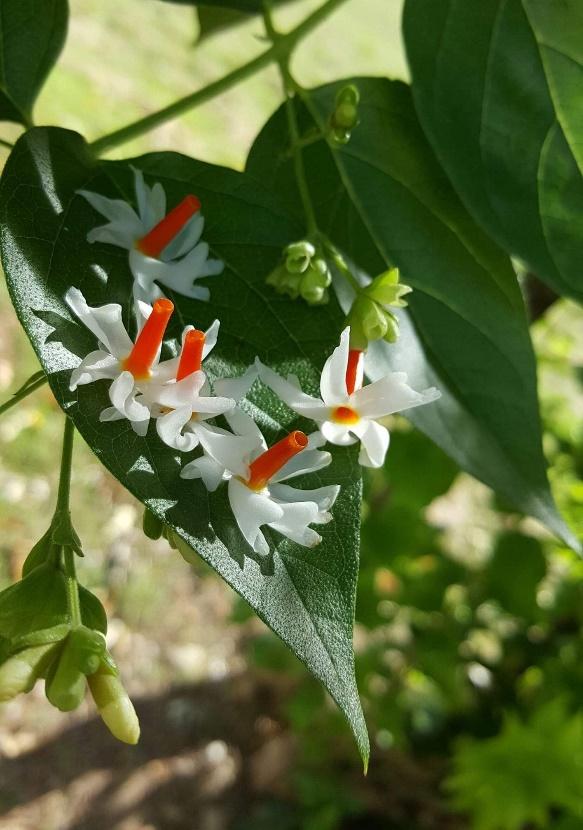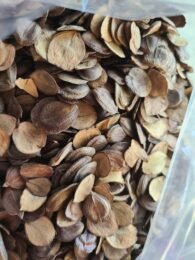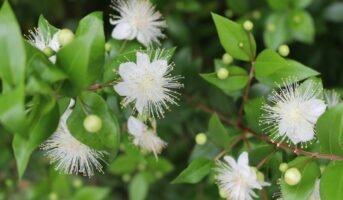What is Parijat plant?
Parijat (Nyctanthes Arbor-Tristis), also known as the Night-Flowering Jasmine or Coral Jasmine, is a species of Nyctanthes indigenous to South and Southeast Asia. Parijat is a member of the Oleaceae family. Despite having a popular name for the genus Jasminum, the plant is not a “genuine jasmine” or even a member of that family. Parijat grows in the outer Himalayas and is found in tracts of Jammu & Kashmir, Nepal to the East of Assam, Bengal, and Tripura, extending through the Central region up to the Godavari in the South. Besides India, they are found in Thailand, Indonesia, Nepal, and Pakistan.
Since the flowers become less vibrant during the day, the tree is commonly referred to as the “tree of sorrow.” The term arbor-tristis also means “sad tree.” In India, parijat is also referred to as “Harsingar or The Gods’ Ornament.” As a result, it is the only flower that can be picked up off the ground and offered to the Gods. It is also stated that the flower helps in recalling the memory of previous lives and incarnations.
Parijat is one of the enchanting and enigmatic plants whose flowers fall on the ground after blooming. The blooms open up at night and fall from the branches as soon as the sun rises. The very sweet floral scent of these beautiful blossoms fills the space with fragrance. The parijat plant is ideal for a sunny balcony and outdoor gardens.

Source: Pinterest
Know about December Flower
Parijat: Key facts
| Botanical Name | Nyctanthes arbor tristis |
| Family | Oleaceae |
| Common Names | Night flowering jasmine, parijat, hengra bubar, harsingar |
| Native | South and Southeast Asia |
| Sunlight | 5 to 6 hours of direct sunlight |
| Soil | Damp, permeable soil that drains well |
| Watering | Moderate |
| Fertiliser | Organic fertiliser |
| Maintenance | Low |
Parijat: Description
- The parijat is an ornamental shrub that can reach heights of up to 13 feet.
- The leaves are alternate, simple, and have an entire border. They measure 6-12 cm (2.4-4.7 in) long by 2-6.5 cm (0.79-2.56 in) wide.
- As its name suggests, night-blooming jasmine produces petite, fragrant, tubular blooms that open at night and have five to eight lobes with an orange-red centre.
- They are developed in groups of two to seven.
- It also bears tiny white berries, which birds consume and disseminate.
- Frequently throughout the summer and spring, night-blooming jasmine produces flowers.
- The fruit is a two-lobed, flat brown, heart-to-round capsule measuring 2 cm (0.79 in) in diameter, each lobe carrying a single seed.
- These incredibly fragrant flowers bloom at night, filling the air with an extraordinarily sweet flowery scent as they release their fragrance.
- August to December sees the blooming of these flowers.
How to grow Parijat plant?
- Parijat is easily grown from a cutting taken from a healthy plant in the spring or early summer.
- Snip a cutting 6 to 8 inches long from a healthy plant just below the node.
- Leave a few leaves at the top and remove all the leaves from the lower area.
- It should be planted in a pot with well-draining potting soil.
- Water it well, then wrap it in a plastic bag.
- Keep the pot in an area with bright, filtered sunlight.
- Additionally, moisten it frequently if the soil feels dry to the touch.
- Within 3–4 weeks following the planting date, the cutting will grow new roots.
- The plant prefers outdoor semi-shade conditions and alternate-day irrigation.
How to grow Parijat from seed?

Source: Pinterest
Here are the steps to grow Parijat plant from seed:
- Collect fresh seeds from the Parijat plant.
- Soak the seeds in warm water for 24 hours to soften the outer shell.
- Fill a seed tray or small pots with well-draining soil.
- Place the seeds on top of the soil and lightly cover them with soil.
- Water the soil gently to keep it moist.
- Place the tray or pots in a warm, bright location but away from direct sunlight.
- Keep the soil consistently moist and avoid over-watering.
- Once the seeds sprout, thin them out and transplant them to larger pots or directly into the ground.
- Provide the plant with adequate sunlight, water, and nutrients to encourage healthy growth.
How to grow Parijat from cuttings?
- Take a healthy cutting from a Parijat plant, preferably from a young stem with softwood.
- Remove the leaves from the lower half of the cutting and dip the cut end in rooting hormone or water.
- Plant the cutting in well-draining soil and keep it moist.
- Cover the pot with a plastic bag or a glass jar so that a humid environment is created and moisture is maintained.
- Place the pot in a bright, warm location but away from direct sunlight.
- After a few weeks, roots will form and the plant will begin to grow.
- Once the plant has established roots, remove the covering and continue to care for the plant with adequate sunlight, water, and nutrients to encourage healthy growth.
How to use Parijat leaves?
Parijat leaves can be used in various ways such as
- making tea
- extracting essential oils
- preparing poultices or pastes for medicinal purposes.
What is Parijat flower called in english?
Parijat flower is also known as Night-flowering Jasmine or Coral Jasmine in English.
Parijat: How to maintain?
Parijat requires initial care for 1-2 weeks after getting it at your place.
Sunlight
- The plant adores the sun.
- After it has grown, keep it in a spot that receives 5 to 6 hours of direct sunlight.
- Avoid growing it in a shaded area since it will result in restricted growth and produce fewer or no flowers.
Soil
- Use healthy, damp, permeable soil that drains well.
- Add organic material to it, such as aged cow dung manure, compost, or vermiculture.
- You can use any common potting soil that is offered for potted plants for containers.
- Additionally, you can make your soil mix by combining equal portions of coarse sand, garden soil, and cow dung manure.
Watering
- Keep the soil wet but not soggy. Only water the soil when you can feel the topsoil is no longer moist.
- Check the moisture level in the soil by poking it with your finger or a plain little stick.
- When the upper inch or two of soil in the pot feels dry to the touch, add 4 cups (about 200 ml) of water.
- Water, ideally in the morning or late at night. Avoid over-watering the plant.
- As a general rule, water the plant extensively in the summer and sparingly in the winter and during the rainy season.
Fertiliser
- Loosen the topsoil before applying fertiliser without disturbing the plant’s roots so that it can absorb nutrients and moisture.
- Feed the plant with organic fertiliser once a month throughout the primary growing season.
- After applying fertiliser, immediately follow up with watering.
Protection
- Get rid of any damaged, diseased, or dead plant portions and dispose of them far from the living plants.
- Neem oil, Eucalyptus oil, or citrus oil spray can be used as an initial treatment for any disease or insect attack.
Don’ts
- Avoid over-watering the plant, particularly if the pot lacks drainage holes.
- Avoid drenching flowers and leaves because doing so could lead to fungal infections.
- Standing water is the biggest threat to this plant since it kills and rots the roots.
- The plants will benefit from annual fertilisation.
- Due to the shoots’ uneven growth, the plant needs to be pruned.
- The section of the garden that is shaded and gets a few hours of direct sunlight is the best place for the plant to flourish.

Source: Pinterest
Parijat: Uses
- Controlling excessive blood sugar levels is one of the main health benefits of parijat.
- The leaves have been used for sciatica, arthritis, and fevers and as a laxative in Ayurvedic and homoeopathic treatment.
- According to studies, parijat leaves are particularly effective in treating malaria symptoms.
- The flowers have sedative, antioxidant, anti-inflammatory, and diuretic properties.
- The leaves have antifungal, antibacterial, antipyretic, anti-oxidative, and anti-inflammatory properties.
- Cures dry cough.
- Due to the presence of ethanol in it, parijat flowers and leaves function as immunostimulatory to strengthen immunity.
- Controls anxiety.
- Relieves the pain of menstrual cramps.
- Avoid dental problems.
- Parijat treats gastrointestinal problems such as hyperacidity, nausea, etc.
- Parijat helps in getting rid of worm infestation.
- Making a tea or decoction out of Parijat’s leaves and blossoms is the simplest way to use it.
- Oil extracted from the plant is used for its healing properties.
- An alcoholic extract called parijat tincture is also used medically.
- A parijat seed decoction eliminates and manages dandruff and head lice.
- To strengthen hair and prevent hair loss, parijat flowers are used as a hair tonic.
- Parijat also helps in preventing other scalp-related conditions, such as hair thinning and greying.
- Stomach ailments of children can be effectively treated by combining the juice of its leaves with a little sugar.
- Parijat is also used to make various “face packs,” as it gives the face a garish shine and provides a guaranteed cure for several skin conditions.
- The parijat tree’s seeds are used to cure skin conditions and constipation.
- The plant can be made into dyes as well. The blooms can be used to make yellow clothing dye.
- In many Assamese culinary recipes, dried flowers and fried young leaves are used.
- Flower oil is also widely used as a fragrance.
- The flower is used to make incense sticks because of its potent aroma.
Parijat: Toxicity
Although this sturdy, fragrant plant attracts butterflies and birds, it is toxic to mammals, including dogs and humans. Prevent your dog from sniffing the plants too much in addition to preventing him from eating them. Some mammals may experience mildly harmful side effects from inhaling the plant’s scent, including nausea, vertigo, and throat- and nose irritation.
FAQs
Which type of soil is ideal for growing parijat?
Parijat grows well in light sandy soil that's moist but well-drained.
Does the fragrance of this flower cause any side effects?
Yes! It can be dangerous for some mammals to smell parijat flowers too closely. The plant's aroma can have mildly harmful effects when inhaled, including nausea, vertigo, and throat and nose discomfort.
| Got any questions or point of view on our article? We would love to hear from you.Write to our Editor-in-Chief Jhumur Ghosh at [email protected] |
Housing News Desk is the news desk of leading online real estate portal, Housing.com. Housing News Desk focuses on a variety of topics such as real estate laws, taxes, current news, property trends, home loans, rentals, décor, green homes, home improvement, etc. The main objective of the news desk, is to cover the real estate sector from the perspective of providing information that is useful to the end-user.
Facebook: https://www.facebook.com/housing.com/
Twitter: https://twitter.com/Housing
Email: [email protected]











